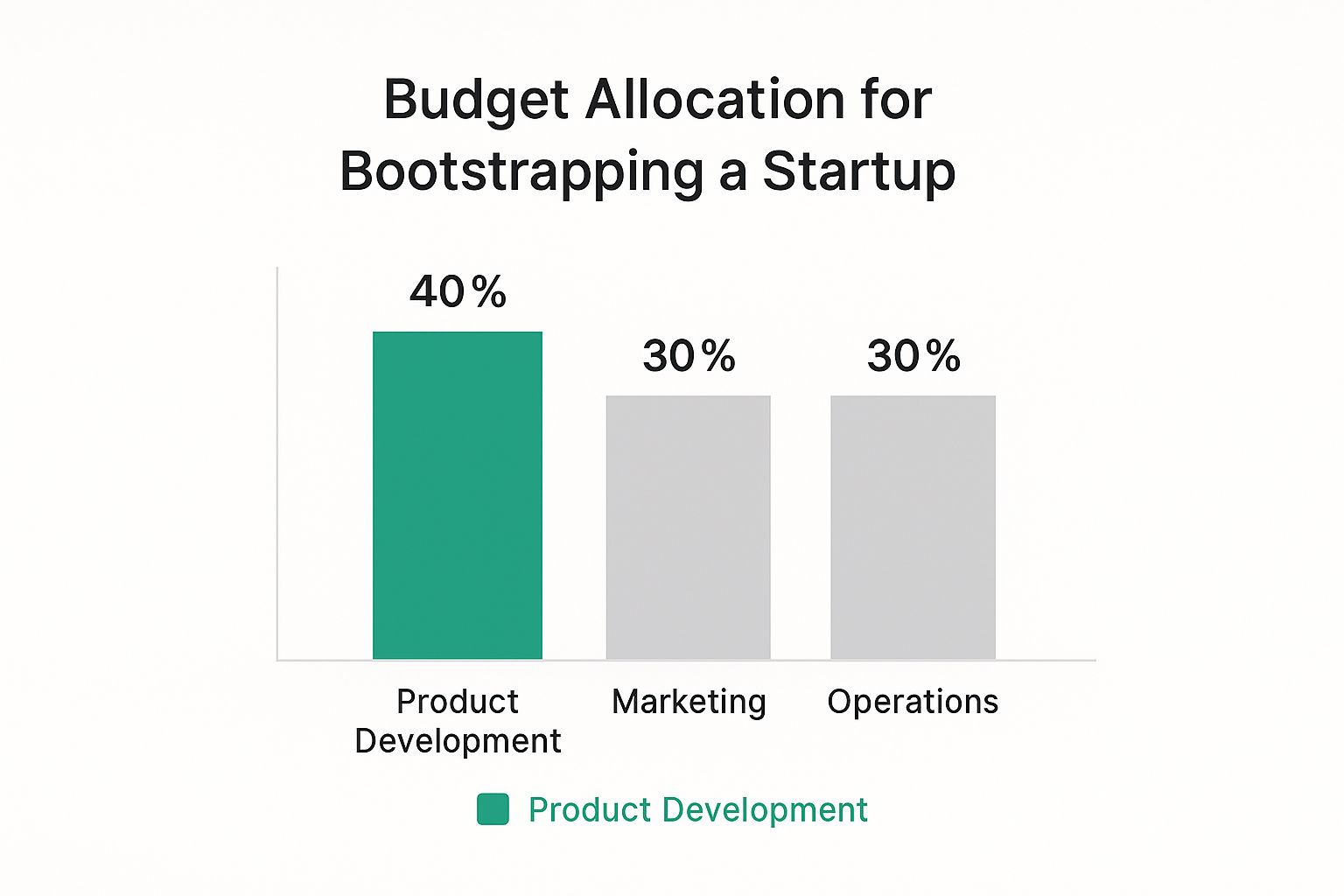Understanding What Bootstrapping a Startup Really Takes

Bootstrapping a startup isn't just about avoiding investors. It's about building a business from the ground up with a completely different approach. It requires a fundamental mindset shift that changes how founders view risk, growth, and opportunity. This section explores the core principles of bootstrapping and what it takes to succeed without external funding.
The Bootstrapper's Mindset
Bootstrapped founders often prioritize long-term sustainability over rapid growth. This means making strategic decisions based on available resources and focusing on generating revenue early. Building a strong community is crucial, and exploring innovative tactics like virtual event engagement ideas can be beneficial.
This community-focused approach aligns perfectly with the resourcefulness inherent in bootstrapping. It encourages founders to be creative and find innovative solutions, maximizing limited resources for the best results. A strong team is essential, and you might consider how to find a technical co-founder to bolster your efforts.
The Advantages of Bootstrapping
Bootstrapping offers distinct advantages. It gives founders complete control over their vision, free from the pressure of investor expectations. This autonomy fosters creativity and allows for quick adaptation to market changes.
Furthermore, bootstrapping necessitates a disciplined approach to finances, building sustainable practices from day one. This focus on profitability can create a more resilient and ultimately more successful business in the long run.
The Risks and Challenges
However, bootstrapping is not without its difficulties. Starting a business is inherently risky, with a high failure rate. Statistics indicate that approximately 80% of startups fail overall. Out of the thousands that launch every year, only around 800 secure Series A funding, and of those, only 10% typically make it to the next stage.
Bootstrapping often requires founders to use personal finances and focus intensely on generating revenue quickly. You can find more detailed statistics on bootstrapping here. This necessitates careful planning, meticulous financial management, and a strong will to persevere through lean times.
Despite the challenges, success stories like Apple and MailChimp prove that building a thriving business without external funding is possible. The disciplined nature of bootstrapping can even lead to faster break-even points compared to venture-backed companies, highlighting the potential rewards of this path.
Building Your Financial Foundation Without External Funding

This infographic illustrates a typical bootstrapped startup budget, split between Product Development, Marketing, and Operations. Notice how 40% goes to Product Development. This underscores its importance in a bootstrapped venture. Both Marketing and Operations receive 30%, showing the need for balance in reaching customers and managing resources effectively.
Smart Ways to Bootstrap Your Startup
Bootstrapping requires a different financial approach than seeking venture capital. It calls for careful planning, resourcefulness, and a laser focus on revenue. Successful bootstrapped founders employ these key strategies:
- Strategic use of personal savings: Your savings become your seed capital. Use it wisely for essential expenses.
- Generating early revenue: Paying customers from the start create a sustainable financial flow. This is a priority.
- Effective cash flow management: Track expenses meticulously and prioritize spending that directly impacts revenue.
- Reinvesting profits wisely: Reinvest strategically in growth areas like product development or marketing once you are profitable.
Making the Most of Limited Resources
Bootstrapping often involves working with limited resources. This constraint can actually boost creativity and lead to efficient resource allocation. Think of it as maximizing the impact of every dollar.
For example, instead of expensive marketing campaigns, consider cost-effective strategies like content marketing and building an organic social media presence. Negotiating better terms with suppliers can also significantly reduce expenses. If you decide to explore other avenues later, you may find this helpful: How to get startup funding.
Financial Projections and Resilience
Realistic financial projections are crucial for bootstrapping success. These projections must consider the challenges of slower growth and limited capital.
Building financial resilience is equally important. This involves having contingency plans for unexpected downturns or slow growth periods. A financial safety net can determine whether you weather a tough period or have to shut down.
Bootstrapping Models for Long-Term Success
Different bootstrapping models exist, each offering a unique approach. Understanding these models can help you choose the right strategy for your startup:
- Lean Startup: Develop a Minimum Viable Product (MVP) and iterate based on customer feedback. This minimizes development costs and maximizes learning.
- Revenue-Based Growth: Prioritize revenue generation from day one and reinvest profits to scale. This creates a self-sustaining growth cycle.
- Owner-Financed: Rely primarily on personal savings and revenue, maintaining complete control and avoiding debt. This requires careful budgeting and financial discipline.
To help visualize the key differences between bootstrapping and VC-backed funding, let's look at a comparison table:
Bootstrapping vs. VC-Backed Funding: Key Differences
A comprehensive comparison of funding approaches, timeline expectations, and success metrics
| Aspect |
Bootstrapped Startups |
VC-Backed Startups |
| Funding Source |
Personal savings, revenue |
Venture capitalists |
| Control |
Founder retains full control |
Shared with investors |
| Growth Trajectory |
Typically slower, more organic |
Rapid growth expected |
| Financial Focus |
Profitability, cash flow management |
Market share, rapid scaling |
| Time to Profitability |
Sooner due to cost control |
May take longer due to high investment |
| Risk Tolerance |
Lower, calculated risks |
Higher risk tolerance for greater potential returns |
This table highlights the core differences in these two funding approaches. Bootstrapping emphasizes control and profitability, while VC-backed funding prioritizes rapid growth and market share, even at the expense of early profits.
By implementing a disciplined financial approach, using creative strategies, and building a solid foundation, you can overcome the challenges of bootstrapping and improve your chances of long-term success.
Mastering Sustainable Growth Without Burning Cash

Bootstrapping a startup demands a different growth strategy compared to venture-backed companies. Instead of chasing rapid, unsustainable expansion, bootstrapped businesses prioritize building predictable and manageable growth. This focus on long-term value creates resilience and allows for strategic scaling based on earned revenue, not investor dollars.
Organic Growth Strategies for Bootstrapped Startups
Organic growth is paramount for bootstrapped startups. This involves strategies that don't heavily rely on paid advertising. Instead, the focus shifts to building a strong foundation through engaged audiences and valuable content.
- Content Marketing: Creating valuable content attracts and engages your target audience. Think blog posts, case studies, ebooks, and webinars.
- Search Engine Optimization (SEO): Optimizing your website and content helps you rank higher in search engine results like Google. This drives organic traffic to your site.
- Social Media Marketing: Building a strong social media presence on platforms relevant to your audience is crucial. This builds brand awareness and generates leads.
- Email Marketing: Nurturing leads and building relationships with customers through targeted email campaigns.
- Community Building: Engaging with your audience through online forums, groups, and events builds loyalty and advocacy.
- Referral Programs: Encourage existing customers to refer new business. This leverages the power of word-of-mouth marketing.
You might be interested in: How to master top startup growth strategies.
Measuring Success on a Bootstrapped Budget
Tracking the right metrics is vital for bootstrapped businesses. This data-driven approach informs decisions, optimizes spending, and ensures a path to profitability.
- Customer Acquisition Cost (CAC): Knowing how much it costs to acquire a new customer is essential. Keeping CAC low is crucial for bootstrapped ventures.
- Customer Lifetime Value (CLTV): Understanding the total revenue a customer will generate over their relationship with your business is key. Maximizing CLTV is vital for long-term profitability.
- Monthly Recurring Revenue (MRR) or Annual Recurring Revenue (ARR): Tracking recurring revenue helps measure the stability and predictability of your income.
- Churn Rate: Knowing the percentage of customers who cancel their subscriptions or stop using your product/service is important. Minimizing churn is essential for sustainable growth.
A solid financial foundation often relies on efficient processes. For further reading, explore Effective Document Management Strategy for Business Success. This careful tracking enables data-driven decisions and ensures a path to profitability. Bootstrapped startups have a different growth trajectory compared to venture-capital-backed companies. While VC-backed companies often experience rapid, hockey-stick growth, bootstrapped companies grow more linearly and steadily. For example, top-performing bootstrapped SaaS companies typically reach $1 million in annual recurring revenue (ARR) in approximately two years. This is only four months slower than their VC-backed counterparts. Find more detailed statistics here. This linear growth reflects a more sustainable model, with revenue generated through sales, not investor funding. This also leads to a higher likelihood of reaching break-even, with bootstrapped startups being 55% more likely to achieve this milestone within two years. This sustainable growth mindset, combined with careful financial management, allows bootstrapped businesses to thrive in the long run.
Navigating Challenges That VC-Backed Founders Never Face
Bootstrapping a startup comes with its own unique set of obstacles. These are challenges that founders with venture capital often don't experience. Bootstrapping tests a founder's resilience and requires a different approach to building a business. Let's explore some of the key hurdles and how to overcome them.
The Psychological Pressure of Self-Funding
One of the biggest differences between bootstrapping and having VC backing is the financial pressure. Bootstrapped founders invest their own money, putting a significant emotional weight on their shoulders. This can manifest in a few ways:
- Fear of Failure: Risking personal savings intensifies the fear of failure, making it harder to take necessary risks.
- Financial Strain: Limited resources mean careful budgeting. This can create added stress and restrict flexibility.
- Slower Growth: Bootstrapping usually leads to slower growth than VC-backed ventures. This requires founders to be patient and focused on long-term goals.
While the pressure is real, it can also be incredibly motivating. The direct link between personal investment and business success can fuel a powerful drive to achieve.
Managing Slower Growth Expectations
Bootstrapping demands a different growth mindset. Instead of rapid scaling, the focus shifts to sustainable growth funded by earned revenue. This change in perspective means:
- Prioritizing Profitability: Generating profit becomes a core focus, guiding decisions on spending and expansion.
- Embracing Patience: Building a successful bootstrapped company takes time. Founders need to embrace patience and focus on the long-term vision.
- Celebrating Small Wins: Acknowledging and celebrating small victories along the way helps maintain momentum and morale.
Overcoming Isolation and Building a Support Network
The bootstrapping journey can sometimes feel isolating. Unlike founders with a network of investors and advisors, bootstrappers often work independently. However, building a strong support system is crucial. Here are some ways to connect:
- Connecting with Other Bootstrappers: Online communities and events for bootstrapped founders offer a sense of community and shared experience.
- Seeking Mentorship: Experienced entrepreneurs who have successfully bootstrapped can provide invaluable advice and guidance. SCORE is one place to find mentors.
- Leveraging Online Resources: A wealth of online resources—from blog posts to podcasts—offers practical tips and inspiration.
By recognizing these unique challenges and adopting effective strategies, bootstrapped founders can build resilience and stay motivated. This path often leads to stronger, more sustainable businesses, built on solid foundations. Bootstrapped founders often emerge with a deeper understanding of their business and a heightened sense of accomplishment.
Learning From Bootstrapping Success Stories That Inspire

Real-world success stories offer invaluable lessons for aspiring bootstrappers. They demonstrate that significant growth is possible without external funding. This section explores inspiring journeys across various industries, highlighting effective strategies and key decisions.
Bootstrapping To Multi-Million Dollar Success: Case Studies
Examining established companies reveals the potential of bootstrapping. Let's look at a few examples:
Mailchimp: This email marketing powerhouse started as a side project. Its organic growth stemmed from a freemium model and effective word-of-mouth marketing. Mailchimp demonstrates the power of niche focus and providing exceptional value.
GoDaddy: Initially funded with personal savings, GoDaddy became a dominant force in domain registration and web hosting. Their relentless focus on customer acquisition and competitive pricing proved highly effective. This highlights the importance of targeting a specific market and employing aggressive marketing tactics.
Shopify: Beginning as an online snowboard shop, Shopify evolved into a leading e-commerce platform. They identified a market need and prioritized user-friendly design. Shopify’s success underscores the value of adapting to evolving customer needs.
The Resilience of Bootstrapped Businesses
Bootstrapping presents unique challenges. While some studies suggest a 90% failure rate within the first five years for bootstrapped startups, those that survive often exhibit greater long-term resilience. Profitability is reportedly 3.6 times higher for bootstrapped companies. Explore this topic further. This focus on efficient resource allocation is key.
Furthermore, bootstrapped companies maintain a 38% survival rate over a decade, nearly double that of VC-backed startups. This highlights the advantages of disciplined financial management.
To better understand these differences, let's look at a comparison:
Bootstrapped vs. VC-Backed Success Metrics
Comparison of key performance indicators and survival rates between different funding approaches
| Metric |
Bootstrapped Startups |
VC-Backed Startups |
Key Advantage |
| 5-Year Survival Rate |
10% |
(Not specified in source) |
(Not specified in source) |
| 10-Year Survival Rate |
38% |
Around 20% (implied from source) |
Bootstrapped |
| Profitability |
3.6x higher (compared to VC-backed) |
Lower (implied from source) |
Bootstrapped |
This data underscores the long-term financial stability often associated with bootstrapping. The focus on profitability and efficient resource management contributes significantly to this resilience.
Key Takeaways From Bootstrapping Triumphs
Analyzing successful bootstrapped ventures reveals common themes:
- Customer Focus: Building a strong community and addressing customer needs are essential.
- Financial Discipline: Careful financial management and prioritizing profitability build a solid foundation.
- Adaptability: Responding to market changes and customer feedback is crucial for sustained growth.
- Long-Term Vision: Patience and building a sustainable business are key, rather than short-term gains.
- Resourcefulness: Maximizing limited resources and finding creative solutions are essential.
These lessons offer invaluable guidance for anyone considering the bootstrapping path.
Applying Bootstrapping Lessons to Your Startup
Here's how you can apply these insights:
- Validate Your Idea Early: Test your concept with minimal investment to gauge market demand.
- Focus on Revenue Generation: Prioritize creating a revenue stream early to fuel growth.
- Build a Strong Brand: Differentiate yourself and foster customer loyalty with a strong brand identity.
- Embrace Continuous Learning: Stay updated on industry trends and adapt to market changes.
By learning from these success stories and implementing these principles, you can build a sustainable and profitable business on your own terms. These examples provide inspiration and practical knowledge to guide you on your bootstrapping journey.
Your Bootstrapping Action Plan: Next Steps That Actually Work
This section offers a practical guide to bootstrapping your startup, turning ideas into action. We'll focus on building a sustainable business from scratch using your own resources.
Validating Your Idea on a Shoestring Budget
Before committing serious time and money, validate your idea affordably. This means getting feedback from potential customers about their needs and how your product or service can address them.
Create a Minimum Viable Product (MVP): Build a basic version of your product with its core features. This Lean Startup approach minimizes initial investment and maximizes learning.
Conduct Customer Interviews: Talk to potential customers to understand their pain points and get feedback on your MVP. These conversations help pinpoint areas for improvement and refine your product-market fit.
Test Your Messaging: Try different marketing messages to see what resonates with your target audience. Clear communication is key to attracting customers and generating interest.
Building a Bootstrapping-Friendly Business Plan
A bootstrapping-friendly business plan prioritizes early revenue, cost control, and efficient resource use. It's a living document that adapts as you learn.
Focus on Revenue Projections: Project realistic revenue based on initial customer acquisition and market analysis. This creates a financial roadmap for growth and sustainability.
Outline Key Metrics: Determine the key metrics you'll track to measure progress and guide decisions. Concentrate on metrics like Customer Acquisition Cost (CAC) and Customer Lifetime Value (CLTV).
Develop a Lean Marketing Strategy: Plan marketing activities around low-cost, high-impact strategies. This includes content marketing, social media engagement, and community building.
Setting Realistic Milestones for Your First Year
Set attainable goals for your first year. Bootstrapped startups often grow slower than venture-backed companies, so manage expectations accordingly.
Prioritize Profitability: Aim for profitability as soon as possible. This creates financial stability and resources for reinvestment.
Establish a Clear Timeline: Create a timeline for hitting key milestones, like launching your MVP, acquiring your first 100 customers, and breaking even.
Build a Strong Team and Partnerships: With limited funding, finding co-founders or partners with complementary skills is crucial. IndieMerger, a platform connecting verified founders, can be a valuable resource.
Essential Tools and Resources for Bootstrapped Startups
Use cost-effective tools to streamline operations and maximize resources. Many free or low-cost options are available for essential functions.
Financial Management Software: Use accounting software to manage finances and track expenses carefully. Many free options exist for startups.
Project Management Tools: Use project management software to organize tasks, collaborate with your team, and monitor progress. Consider tools like Asana or Trello.
Cost-Effective Marketing Platforms: Explore affordable or freemium marketing platforms to reach your target audience without overspending. Mailchimp is a good option for email marketing.
Recognizing When External Funding Might Make Sense
While bootstrapping emphasizes self-funding, external funding can be helpful at certain points. Knowing when to consider outside investment is key.
Sustainable Growth: If your business shows consistent organic growth and needs capital for scaling, exploring funding might be appropriate.
Strategic Partnerships: Look for funding aligned with your long-term vision and values. Strategic investors can provide not only capital but also valuable industry connections and expertise.
By following this action plan and tailoring it to your specific situation, you can successfully launch and grow your startup on your own terms. The journey may be demanding, but building a sustainable, profitable business is immensely rewarding. Ready to find a co-founder? IndieMerger connects founders seeking complementary skills. Build your team and increase your chances of success.